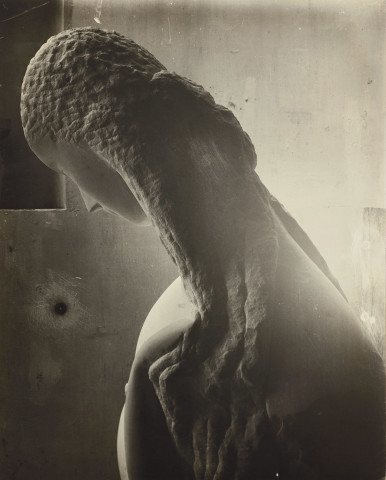Frame Size 46 x 40.3 cm
Brancusi remembered “She had a beautiful bust, but ugly legs and was terribly vain, she was looking in a mirror all the time, even during lunch…discreetly placing the mirror on the table, looking furtive. She was vain and sensual.” This perfectly describes the sculpture he subsequently carved in stone Woman Looking in a Mirror in 1909.
But Brancusi refused to part with the sculpture and instead Princess Maria received a gouache painting.
During 1909 there is a shift in Brancusi’s perspective away from a figurative outlook, towards purity and simplification. The Woman Looking in a Mirror, is the pivotal catalyst for this launch in Brancusi’s sculptural career. Which puts him in the highest regard as the most important sculptor in the history of Modern Art.
In 1912, just 3 years after carving Woman Looking in a Mirror of the Princess, the artist photographed, drew, and painted the sculpted piece. Before re-carving it into the work we know as Princess X.
This extraordinary progression adds priceless value to the remaining 5 gouache and 3 drawings and the photograph of Woman Looking in a Mirror. These provide significant clues into our understanding of the artist’s vision and priorities and his desire to further art history. It is a real movement. And the sculpture, which no longer exists, Brancusi made sure to record and illustrate in articles and exhibitions on his work during his lifetime. That he chose to continue with this sculpture rather than begin a new piece is significant. It demonstrates his intention to simplify, as well as conceptualize his feelings toward his subject, The Princess. His personal understanding of her, in time, laid bare by her public notoriety as the lover of the French President, Muse to Freud and author of studies into female sexuality.
Princess X was one of Brancusi’s most controversial works, the bronze version was temporarily banned at the 1920 Salon des Independents in Paris on the grounds of obscenity.
“C’est la femme!” It is woman! Was Brancusi’s response to the slight. “It is the very synthesis of Woman; it is the eternal female of Goethe, reduced to her essence”.
The re-carving of Woman Looking in a Mirror, into Princess X is not only a work of simplification but marks a movement into Abstraction and also a bold inaugural statement into conceptualism. I cannot draw parallel to a more insightful and ironic depiction and progression of a subject.
Provenance
Collection of John Quinn, New YorkMarc Pagneux, Paris
Christie's New York: Thursday, February 18, 2016 [Lot 00128]
Modern Visions: Exceptional Photographs $43,750
Exhibitions
Impasse Ronsin, Paul Kasmin Gallery, New York, 2016.Brancusi and Duchamp, The Art of Dialogue, Kasmin, New York, 20th September - 22 December 2018
Literature
Marie Bengesco, “L’Art en Roumanie”, La Roumanie en images, 1, Paris, L’Hoir,Illustrated, P96Alfred Dreyfus, Der Querschnitt, 1923, Constantin Brancusi, Nomber 3-4, Berlin, illustrated page 117
V.G. Paleolog, C.Brancusi, Craiova, Ramuri, 1938, Illustrated page 15V.G. Paleolog, a Doua carta despre C.Brancusi, Craiova, Ramuri, 1944, Illustrated page 18
Pontus Hulten, Brancusi Photographe, Centre Pompidou, Paris, 1982, p. 77.Friedrich Tejah Bach, Brancusi, Photo Reflection, Didier Imbert Fine Art, Paris, 1991, pl. 27-29.
Les carnets de l’atelier Brancusi, La série et l’œuvre unique, Princess X, Éditions Georges Pompidou, Paris, 1998, p. 67.
Catalogue d’exposition, Constantin Brancusi, The Essence of Things, Tate publishing, Londres, 2004, p. 26.
Doïna Lemny, Brancusi : Au-delà de toutes les frontières, Fage Editions, Lyon, 2012, p. 68.
Doina Lemny, Constantin Brancusi, Centre Pompidou, Paris, 2012, illustrated page 43
Brancusi and Duchamp, The Art of Dialogue, Kasmin, New York, 20th September - 22 December 2018, page206
Paola Mola, Brancusi Fotografo, Abscondita, 18 MnemosyneMilano, 2013, illustrated plate12
Catalogue d’exposition, Impasse Ronsin, Paul Kasmin Gallery, New York, 2016, p. 212Catalogue d’exposition, Brancusi, La sublimation de la forme, Snoeck Publishers, Bruxelles, 2019, pl. 158.
Modigliani, The Primitivist Revolution, The Albertina Museum, Vienna, September 17,2021 - January 9.2022, Reproduced page 168
Doina Lemny, Brancusi et ses Muses, Editions Gourcuff Gradenigo, Paris,2022, illustrated page 14
